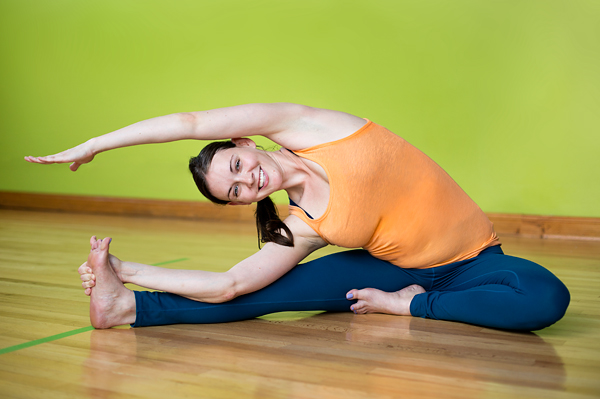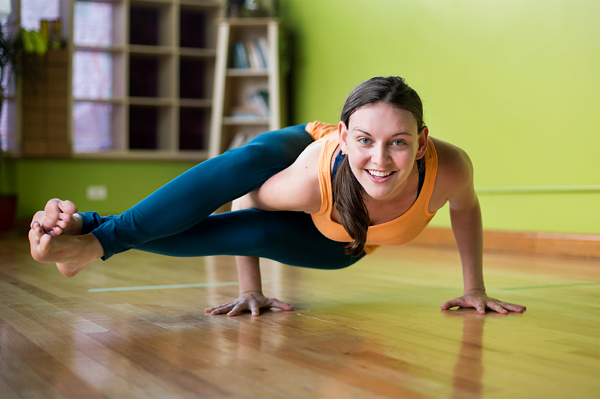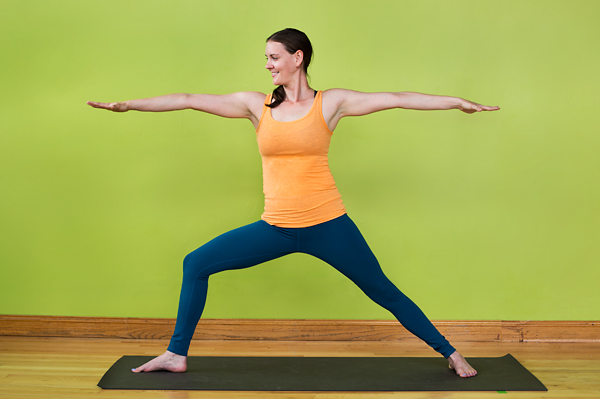
Yoga for beginners does not typically begin as pure bliss, accented with melodious oms. At the start, yoga can be a bit baffling. You have to decide which yoga class to try at which studio, learn what the teacher means when they announce it's time for downward dog, and even figure out what to wear under your yoga pants.
Just remember one thing: however you choose to practice, it's the right path for you.
This is advice from Brentan Schellenbach, co-owner and head teacher at Fermata Yoga Center in Chicago. Below she shares with us five more additional tips for new yogis trying to find their bearings.
Understand the different types of yoga.
First and foremost, Brentan says that the best yoga for beginners is “whatever makes them excited to try.”
Yoga for Stress Relief
If you’re seeking stress relief, Brentan recommends relaxing, slower-paced styles such as gentle yoga and Yin yoga. Think plenty of stretching, deep breathing, and a nice cool down that feels like taking a nap (lavender eye pillows are often included).
Yoga for a Mind-Body Connection
If you’re very interested in learning about how to integrate mind and body, try Hatha yoga, in which you hold each posture for 5–10 breaths before moving on to the next part of the sequence. You’ll get to know yoga poses well and learn how to enter, sustain, and exit them.
Yoga for Exercise
If you’re more interested in bending, sweating, and burning calories, you might feel engaged in a style that moves quickly between poses, like Flow, Vinyasa, or Ashtanga.
“There are some people who, unless they’re in a flowing class, they’re going to be distracted, they’re going to be bored, they’re going to leave that environment feeling like, what’s the point of this?” Brentan says.

Look for yoga studios and teachers with your kind of vibe.
“You want to find the teachers that help make yoga make sense to you,” Brentan says. When you respond to their approach, “Your internal reaction to that [should be]: Wow, yes, wow, cool! I didn’t know how to do this. This is just so different from how I normally do this pose, it’s so great.”
It could take as long as a year of practice to truly determine your preferences for teaching style and environment. You could find your place almost anywhere, though Brentan thinks it’s more likely to be at a yoga-focused facility versus something like a gym that offers yoga classes.
To her part, Brentan defines her yoga teaching style as “experiential anatomy.” Instead of just demonstrating a pose and using simple verbal cues—like “push through your hands and engage your tricep”—Brentan takes her time to ensure each student knows what should be happening to their body. After all, not everyone know what an engaged muscle feels like or even what the tricep is, let alone the other 600-something muscles in the body.
“It’s more like, this is what this joint is about. These are the different muscle actions that can help it do those things. And now let’s feel something. Get into this posture and press down through here and feel your arms sensationalize equally from the finger to the shoulder.”
Honing this instructional style has allowed Brentan to conduct entire yoga classes while seated or walking around. That way, students get a good understanding of each pose instead of merely copying what she’s doing.

Don’t compare yourself to others.
Insanely flexible, strong yogis doing handstands and backbends are over-represented in the popular perception of yoga. It’s probably the most intimidating part of yoga for beginners.
Brentan asks students to remember that they’re practicing alongside people of all sorts of abilities, motivations, and levels of experience. For instance, it's really common for someone with three classes' worth of experience to be practicing alongside someone who has three years' worth of experience. Brentan stresses that people should focus on their own practice and goals.
"Let's have the beginning students feel empowered right from the beginning," she says, "not like they have to take 30 classes before they start to see some benefit."
Be honest with the teacher.
Before class, let them know about any injuries or weaknesses you might have. Tell them how comfortable you are with being touched, since physical adjustments by the teacher can be a crucial part of instruction. Ask to be placed in the back of the classroom if you don’t want to feel put on the spot.
And, within reason, be willing to understand that a teacher can’t read your body 100% accurately. You might both discover you have a physical limitation in the middle of a class.
Students “may not know that they have weakness in their shoulders because they’ve never used their shoulders in this capacity before,” Brentan says. “People just don’t have the awareness of their bodies.”
Adjust your idea of goals.
“No pain, no gain” isn’t an adage that translates well to yoga, at least in Brentan’s opinion.
“We could replace ‘goal’ with a ‘willingness to work at the edge of our skillset,’ and we’ll actually get much more out of our practice,” she says. “Because a goal is so future-oriented, it’s not helping to build a pathway from Point A to the goal itself.”
Instead, each day’s practice forces you to readjust what’s at the edge of your skillset, adding another stepping stone along the path. As you keep moving that edge ahead, you’ll eventually reach a point where you accomplish something big—doing the crow pose, for instance. And then you start with another edge along a path to something new.
“The aspect of the goal that’s important is the motivation to keep doing it,” she says.
Now it's time for a pep talk:
Photos by Matt Schwerin, Groupon; video by Groupon





